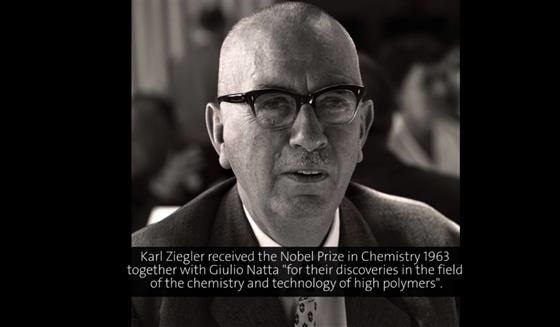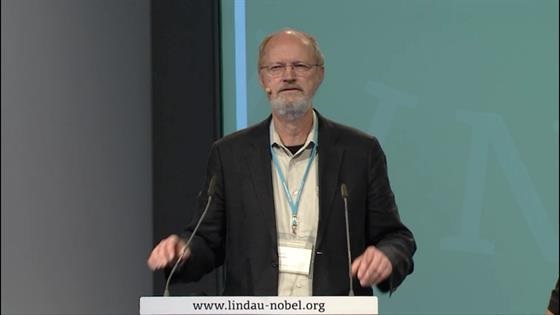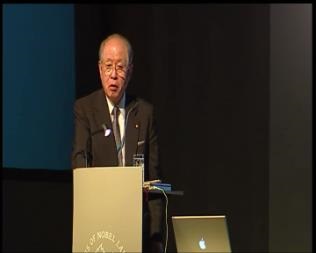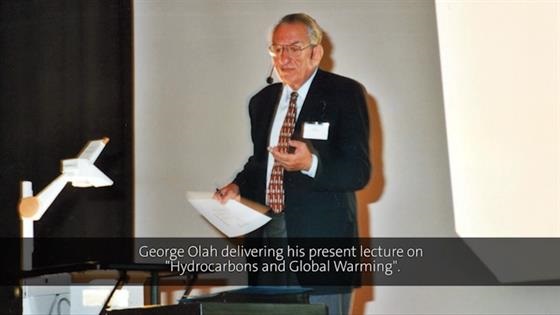Polymers
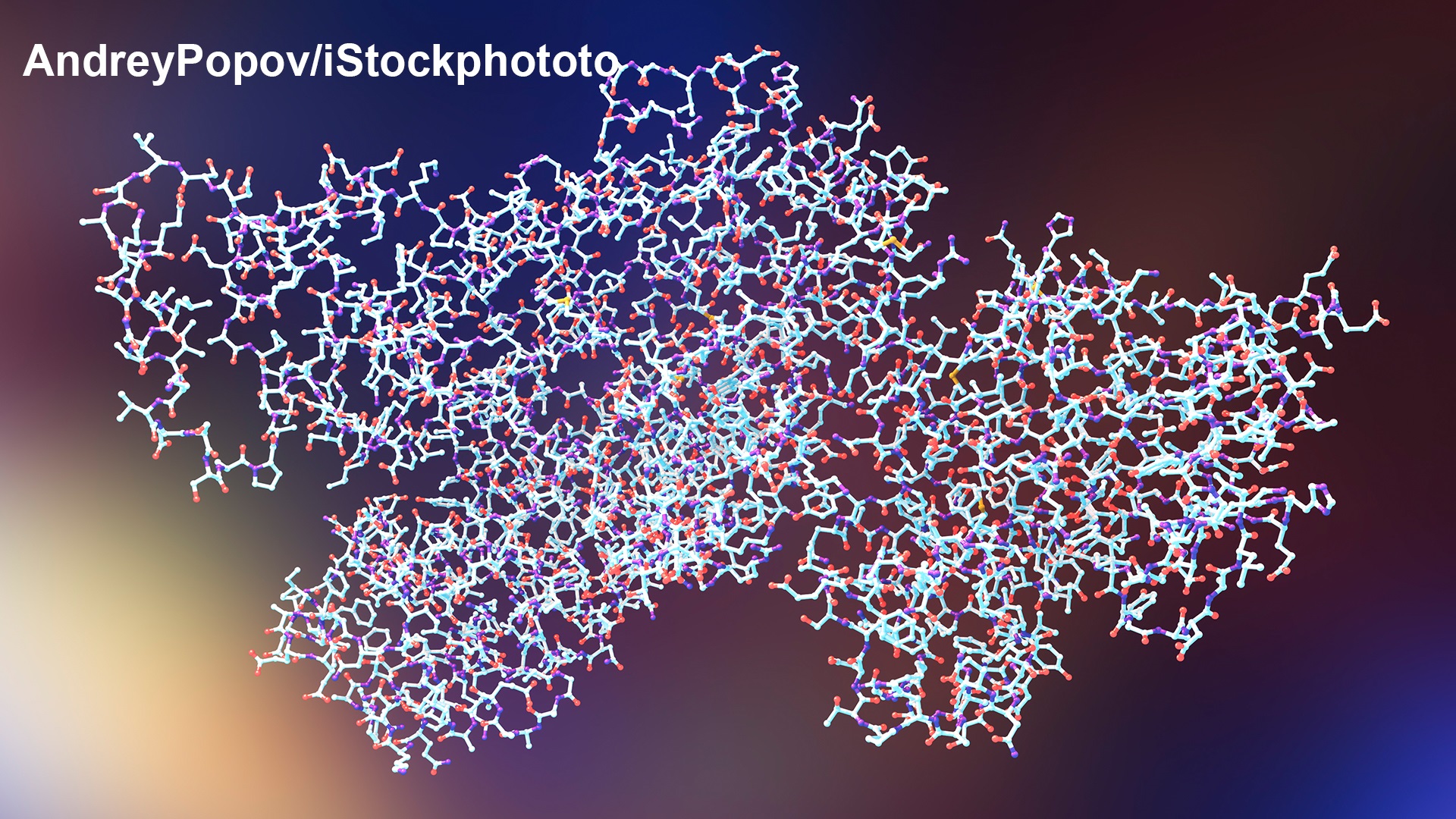
by Hanna Kurlanda-Witek
Polymers are defined as macromolecules, which are made up of small monomer molecules. In the simplest graphic form of description, they are like beads strung on a piece of string, where one bead represents one monomer. This broad definition encompasses much of what we are made of and what surrounds us. Proteins, nucleic acids, polysaccharides such as cellulose, minerals such as quartz and feldspar, as well as the multitude of man-made materials – concrete, glass, plastics and silicones, are all polymers. Nobel Laureate Paul J. Flory gave a brief yet thorough introduction to the subject in his lecture at the 27th Lindau Nobel Laureate Meeting, dedicated to chemistry, in 1977:
(00:00:43 - 00:01:46)
The complete video is available here.
One Hundred and Fifty Years of Plastics
The year 2019 marked the 150th anniversary of the development of the first semi-synthetic polymer; essentially the first commonly used plastic. Cellulose nitrate, or “celluloid”, was invented by John Wesley Hyatt in 1868, after a company in New York offered a $10,000 prize to find a synthetic substitute for ivory [1]. Billiards was becoming a popular game and billiard balls, which were made out of expensive ivory obtained from elephant tusks, were constantly in demand [2]. The 31-year old Hyatt, who worked as a printer during the day, came up with the compound by stabilising the ester of cotton-derived cellulose (used as an explosive) with camphor [3]. The invention became a widespread commercial success and soon everyday objects in all shapes and colours, from knife handles to knitting needles to hair combs were made from celluloid. Hyatt became an established inventor and is said to never have claimed the $10,000 [1].
As with the mouldable and less-expensive Bakelite, the first fully synthetic plastic, formulated by Leo Baekeland in 1907, within several decades celluloid became substituted with newer, more durable plastics. Celluloid and Bakelite items are now valuable collectables, prized by online auction buyers and museum curators [4]. Hyatt’s billiard ball is on display at the Smithsonian National Museum of American History in Washington, D.C. [1]. It may seem difficult to comprehend from today’s perspective, where most things are made of plastic and the use of natural materials is encouraged, but at the beginning of the 20th century plastics were viewed as a remedy for the overuse of nature’s resources. Hyatt’s company stated in a pamphlet, “As petroleum came to the relief of the whale (...) so has celluloid given the elephant, the tortoise, and the coral insect a respite in their native haunts; and it will no longer be necessary to ransack the earth in pursuit of substances which are constantly growing scarcer” [5].
From Small Molecules to Macromolecules – Hermann Staudinger
Although the innovation and manufacturing of synthetic polymers flourished, the establishment of chemical structure of polymers in general was not as swift. Nobel Laureate Emil Fischer postulated in 1906 that proteins were polypeptides consisting of amino acid monomers linked together with stable covalent bonds, yet he doubted that macromolecules with a very large amount of monomers could exist. It was the chemist Hermann Staudinger who claimed that immense polymer chains made up of covalently linked monomers formed the structure of polymers like polystyrene, polyvinyl chloride and natural rubber. Staudinger had initially dedicated his scientific career to organic chemistry of small molecules. Some of his earlier achievements were the synthesis of pepper and coffee flavour, important at the time of World War I when there were shortages of these foods. At around 1920, Staudinger decided to completely change his research focus to polymer chemistry. Two years later, Staudinger’s experiments on the hydrogenation of natural rubber were described in a paper, where he first used the term “macromolecules”. Despite this success, Staudinger’s work on polymers was not universally accepted by scientists in the field until the 1930s [6]. In 1953, Staudinger became the sole recipient of the Nobel Prize in Chemistry, “for his discoveries in the field of macromolecular chemistry” [7]. He gave one lecture at Lindau, on micro- and macromolecular chemistry:
The complete video is available here (German presentation).
Stockings Turned Into Parachutes – the Explosion of Polymer Production After World War II
During the 1920s and 1930s, new polymers, such as polystyrene, polyvinyl chloride (PVC) and high-pressure polyethylene were introduced. In 1935, Wallace Carothers invented nylon, which meant to imitate silk, but was soon widely used by the military in World War II. The war galvanised research in new polymers, synthetic rubber being a notable example [8]. Polymer production increased by 300% in the United States and demand kept rising after the end of the war [2]. At the time Staudinger was being awarded the Nobel Prize in Stockholm, a German professor named Karl Ziegler was carrying out important experiments on polyethylene with regard to speeding up the polymerisation process. Triethylaluminium, an organometallic catalyst, was used, and the experiment was carried out at normal pressure, rather than at 1000-2000 atmospheres as was the rule in the industrial process at that time. The result was a much more sturdier plastic, owing to the linear arrangement of ethylene molecules, whereas high-pressure polyethylene had a more branched structure. This process was also cheaper and the production of low-pressure polyethylene “exploded” only two years later, in 1955, as Ziegler himself described in his Nobel lecture [9].
In Italy, Ziegler’s colleague Giulio Natta was working with another polymer, polypropylene. He used “Ziegler’s catalyst”, as well as titanium tetrachloride (TiCl4) in the process. Natta’s research group in Milan developed X-ray diffraction methods for the study of the structure of synthetic polymers [10]. What was essential in the work was that the molecular side chains of the polymer were found to alter its physicochemical and mechanical properties. For example, polypropylene with randomly oriented methyl side groups produce a rubbery material, while polypropylene with interchangeable methyl groups has a more rigid structure [11, 12]. Ziegler and Natta were awarded the Nobel Prize in Chemistry in 1963, “for their discoveries in the field of the chemistry and technology of high polymers”. The so-called “Ziegler-Natta catalysts” are still used in industry, and polyethylene and polypropylene are one of the most frequently produced plastics [13]. Ziegler attended two meetings in Lindau and gave one talk in 1964, outlining the complete scientific development that led to the invention of the famous Ziegler-Natta catalyst.
The complete video is available here (German presentation).
New Insights Into Macromolecular Chemistry
When Paul Flory delivered his only lecture at Lindau, in 1977, he stated that the theory of macromolecular chemistry is ahead of experiments, and there are many interesting experiments that could and should be done:
(00:26:50 - 00:27:52)
The complete video is available here.
Flory obtained the Nobel Prize in Chemistry in 1974 for research on polymer-solution thermodynamics and for defining theories that could compare properties of different polymers. He described the excluded volume effect, whereby the molecules of a polymer chain cannot cut across one another. The volume taken up by the polymer is inaccessible to the solvent’s molecules. The polymer chains are considered impenetrable but can induce attractive and repulsive forces between molecules and thus influence the conformation of the polymer chain. Flory proposed what has since been called the “Flory temperature”, a property of a particular polymer, where the attractive and repulsive forces between a polymer and its solvent become neutralised, cancelling the excluded volume effects, and the polymer is in an ideal state. These theories were demonstrated as correct by subsequently carrying out experiments on the ideal behaviours of both natural and synthetic polymers [14, 15, 16].
In this part of the lecture, Flory speaks of the future of synthetic polymers, and how “intervention into the rigidity of the molecule”, or studies in the molecular dynamics of polymers, can find many technological innovations in areas such as energy and transportation.
(00:45:55 - 00:49:01)
The complete video is available here.
Polymers Conducting Electricity
In the year of Flory’s lecture at Lindau, an important paper was published in the Journal of the Chemical Society, Chemical Communications. The paper, titled “Synthesis of electrically conducting organic polymers: halogen derivatives of polyacetylene, (CH)x”, marked a new phase, the start of a “fourth generation of polymeric materials” [17, 18]. The paper was co-authored by Alan G. MacDiarmid, a professor of chemistry at the University of Pennsylvania; Hideki Shirakawa, a post-doc at MacDiarmid’s laboratory; and Alan J. Heeger, professor of physics at the University of Pennsylvania.
The synthetic polymers that were known until that time, and studied by Staudinger, Ziegler, Natta and Flory, all concerned saturated polymers, where the four valence electrons of carbon in the molecules are linked to neighbouring atoms with covalent bonds. Conjugated polymers have alternating single and double bonds between carbon atoms – this allows the polymer to possess a small conductivity. In order to intensify the conductivity, the polymer must be doped, whether by addition of an electron (reduction) or removal of an electron (oxidation) from the polymer backbone [19]. This process allows for, “dramatic changes in the electronic, electrical, magnetic, optical, and structural properties of the polymer”, as MacDiarmid explained in his Nobel lecture, essentially making the polymer as conductive as a metal.
For this research, MacDiarmid, Heeger and Shirakawa were awarded the Nobel Prize in Chemistry in 2000. Since that time, the number of conductive polymers has increased, with applications in anti-static materials and many potential uses in biomedicine and electronics, such as organic light emitting diodes and organic solar cells. However, the original conducting polymers have insufficient mechanical properties, processability, and may induce a negative response in a living host due to toxicity. This has paved the way for research in conductive polymeric composites consisting of biostable polymers, such as carbon nanotubes and graphene, as well as metal nanoparticles [20].
Metathesis, Green Chemistry and Bioplastics
Synthetic polymers dominate our everyday lives. Most items within our reach are made from polymers, to the point that we do not even realise. There is no turning back, no future etched in wood and bone. But the growing awareness of the short lifespan of many plastic products, leading to their unnecessary accumulation in the environment must eventually introduce an alternative to how things are made. In 2005, Yves Chauvin, Richard R. Schrock and Robert H. Grubbs won the Nobel Prize in Chemistry “for the development of the metathesis method in organic chemistry.” The principle of metathesis is that double bonds between carbon atoms are broken and formed elsewhere within the molecule, repositioning atom groups. The reactions are catalysed by metal catalysts [21]. This important new feature of organic synthesis highlights a more sustainable approach to the production of chemicals, using fewer resources and producing less waste. Robert H. Grubbs began his lecture at Lindau by introducing the concept of “green chemistry”:
(00:01:12 - 00:03:00)
The complete video is available here.
Nobel Laureate Ryoji Noyori (2001) also mentioned the importance of green chemistry, not only with respect to materials science, but also pharmaceuticals:
(00:03:34 - 00:06:11)
The complete video is available here.
In a debate on Green Chemistry during the Lindau Online Science Days 2020, Professor Noyori underlined the significance of synthetic polymers in the ongoing COVID-19 pandemic:
(00:03:36 - 00:05:10)
The complete video is available here.
Nearly two decades ago, Nobel Laureate George A. Olah told his audience at Lindau that nature gave us a great present in the form of fossil fuels. The ubiquitous presence of synthetic polymers is due to the production of hydrocarbons, particularly crude oil. Olah proposed the idea of a “methanol economy” as a means of transition from fossil fuel energy. Here, Olah explains how ethylene can be made from methanol, the simplest alcohol:
(00:24:02 - 00:27:57)
The complete video is available here.
Ethylene and propylene both belong to a group of hydrocarbons known as olefins, or alkenes. They are unsaturated hydrocarbons, meaning that there is at least one double bond between the carbon atoms in the chain. The first “methanol-to-olefin” (MTO) plant was built in Baotou, China in 2010, producing ethylene and propylene from coal-derived methanol [22]. It is not an ideal alternative, since the technology is still based on energy from fossil fuels, but it decreases the dependence on oil.
Another promising aspect of the future of synthetic polymers is the manufacturing of bioplastics – polymers made from plants. There is still much debate over whether these plastics are better for the environment, considering that most are derived from food crops that use valuable resources. There is also the problem of ensuring that products made from bioplastics are efficiently composted, otherwise they contribute to waste in the same manner as petroleum-based plastics. But with the amount of research conducted on new technologies, we can be confident that more chapters will be added to the history of synthetic polymers. And it all started with a billiard ball!
REFERENCES
[1] https://americanhistory.si.edu/collections/search/object/nmah_2947
[2] https://www.sciencehistory.org/the-history-and-future-of-plastics
[3] https://www.getty.edu/conservation/publications_resources/pdf_publications/pdf/nitrate.pdf
[4] http://www.amsterdambakelitecollection.com/pdf/Plastiquarian_55_ABC-2017-06.pdf
[5] Freinkel, S. (2011) A Brief History of Plastic’s Conquest of the World. Scientific American https://www.scientificamerican.com/article/a-brief-history-of-plastic-world-conquest/
[6] Mülhaupt, R. (2004) Hermann Staudinger and the Origin of Macromolecular Chemistry. Angewandte Chemie International Edition 43, 1054 – 1063.
[7] https://www.nobelprize.org/prizes/chemistry/1953/summary/
[8] https://www.nobelprize.org/prizes/chemistry/1974/flory/biographical/
[9] https://www.nobelprize.org/uploads/2018/06/ziegler-lecture.pdf
[10] http://www.giulionatta.it/ENG/parte_I.html
[11] https://www.nobelprize.org/prizes/chemistry/1963/summary/
[12] https://www.chemistryworld.com/features/paving-the-way-to-polythene-/6675.article
[13] https://www.mediatheque.lindau-nobel.org/videos/31525/from-triphenylmethyl-to-polyethylene-less-well-known-facts-about-the-developments-leading-to-the-invention-made-in-muelheim-german-presentation-1964/topic-carbon
[14] https://www.nobelprize.org/prizes/chemistry/1974/press-release/
[15] https://www.nobelprize.org/prizes/chemistry/1974/flory/biographical/
[16] Johnson, W. S., Stockmayer, W. H., and Taube, H. (2003). Biographical Memoirs, Vol. 82, Paul John Flory, pp. 115 – 126. https://www.nap.edu/read/10683/chapter/8#124
[17] https://www.nobelprize.org/uploads/2018/06/heeger-lecture.pdf
[18] https://pubs.rsc.org/en/content/articlelanding/1977/c3/c39770000578#!divAbstract
[19] https://www.nobelprize.org/uploads/2018/06/macdiarmid-lecture.pdf
[20] Kaur, G., Adhikari, R., Cass, P.,Bown, M., and Gunatillake, P. (2015). Electrically conductive polymers and composites for biomedical applications. RSC Advances 5, pp. 37553-37567. https://pubs.rsc.org/no/content/articlehtml/2015/ra/c5ra01851j
[21] https://www.nobelprize.org/prizes/chemistry/2005/press-release/
[22] Boltz, M., Losch, P., and Louis, B. (2013). A General Overview on the Methanol to Olefins Reaction: Recent Catalyst Developments. Advanced Chemistry Letters 1(3), pp. 247 – 256.
[23] Tolinski, M. (2012). Plastics and Sustainability. Towards a Peaceful Coexistence between Bio-based and Fossil Fuel-based Plastics. Scrivener Publishing.

.jpg?638021985227700000)

